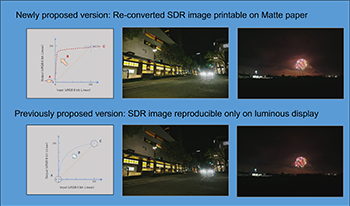
Printing display images normally proceeds well provided they comply with the SDR gamut supported by color management systems (CMS), like ICM used in Windows OS. Twilight vision, unfortunately, complicates this process, as it is quite difficult to convert images captured by UHDR systems given that their contrast ratios (CR) sometime exceeded 10^6:1 or so; SDR images have CR values of approx. 100:1. A typical example is the reproduction of lunar texture. Quite recently, we resolved this problem by employing just global tone mapping (GTM). Even with the use of GTM, emissive displays like LCD, not projection displays or printed matter, are strongly recommended to prevent image quality degradation. This study addresses the reasons why CMS fail to handle twilight vision material well and proposes enhanced GTM for printing emissive display images. The main point is the difference between the perception responses demonstrated in daytime and in twilight, even after the UHDR material is converted into SDR images. In other words, the key idea is to focus on the underutilized top and bottom margins of the reproduced SDR images. From another viewpoint, the most important result is the acquisition of super sensitivity. Our proposal enables high sensitivity even with the same sensor (increase is approx. 10 to 30 times).

White balance is one of the key processes in a camera pipeline. Accuracy can be challenging when a scene is illuminated by multiple color light sources. We designed and built a studio which consisted of a controllable multiple LED light sources that produced a range of correlated color temperatures (CCTs) with high color fidelity that were used to illuminate test scenes. A two Alternative Forced Choice (2AFC) experiment was performed to evaluate the white balance appearance preference for images containing a model in the foreground and target objects in the background indoor scene. The foreground and background were lit by different combinations of cool to warm sources. The observers were asked to pick the one that was most aesthetically appealing to them. The results show that when the background is warm, the skin tones dominated observers' decisions and when the background is cool the preference shifts to scenes with same foreground and background CCT. The familiarity and unfamiliarity of objects in the background scene did not show a significant effect.

Contrast sensitivity functions (CSFs) describe the smallest visible contrast across a range of stimulus and viewing parameters. CSFs are useful for imaging and video applications, as contrast thresholds describe the maximum of color reproduction error that is invisible to the human observer. However, existing CSFs are limited. First, they are typically only defined for achromatic contrast. Second, even when they are defined for chromatic contrast, the thresholds are described along the cardinal dimensions of linear opponent color spaces, and therefore are difficult to relate to the dimensions of more commonly used color spaces, such as sRGB or CIE L*a*b*. Here, we adapt a recently proposed CSF to what we call color threshold functions (CTFs), which describe thresholds for color differences in more commonly used color spaces. We include color spaces with standard dynamic range gamut (sRGB, YCbCr, CIE L*a*b*, CIE L*u*v*) and high dynamic range gamut (PQ-RGB, PQ-YCbCr and ICTCP). Using CTFs, we analyze these color spaces in terms of coding efficiency and contrast threshold uniformity.